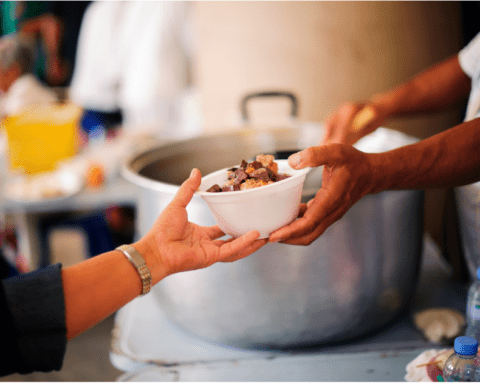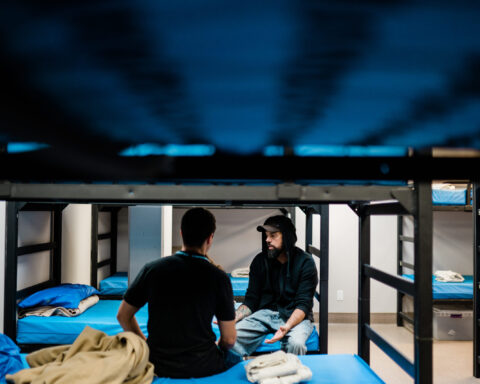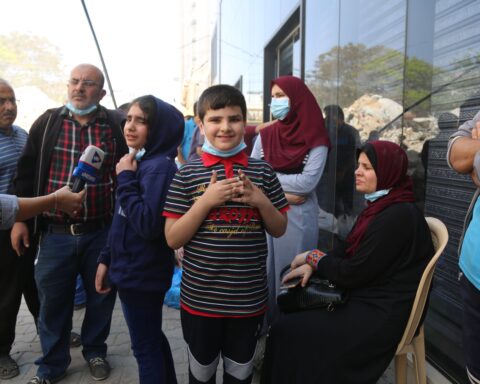When Syrian refugee children arrive in Canadian classrooms for the very first time, the anxiety they feel might be more than simply first-day-of-school jitters, say humanitarian relief workers and health-care providers.
Many may be experiencing the trauma of loss and displacement after months, if not years, of being out of school. Despite this stress, heading back to class is the best course to establishing a sense of normalcy, says Patricia Erb, CEO of Save the Children, a global humanitarian agency.
“The children have gone through incredible trauma. They’ve seen people die, their schools being bombed,” says Erb. “Getting into a school is getting back to a normal life. That’s what they beg for.”
The role of psychosocial programs
Ontario is expected to absorb about 4,000 of the 10,000 refugees expected to arrive by year’s end. The federal government plans to resettle 25,000 Syrian refugees across Canada by February 2016.
Nearly five years into the Syrian conflict, as many as 2.2 million children are living as refugees, with limited access to education and psychological support. In a recent report titled Childhood in the Shadow of War, Save the Children says that one in four Syrian refugee children are at risk of developing a mental health disorder.
Psychosocial programs, which can involve art or play therapy, have helped children make sense of what happened and build their resilience, says Erb.
“The children have gone through incredible trauma. They’ve seen people die, their schools being bombed.”
And yet these initiatives often receive the least funding, as resources in host countries are stretched thin, says the report.
In tents reserved as safe spaces for children at refugee camps, Save the Children runs activities where the children are asked to draw or dramatize their experiences. Their sketches can provide a glimpse into their emotional state.
“In their drawings, there’s blood, body parts that are separated,” she says. “You see the war.”
The impacts of trauma
While visiting a refugee camp in Jordan, Erb was struck by the behaviour of three- and four-year-olds. “They were coaxed to eat their snacks, but they just wanted to put it in their backpacks. They had that memory of not having enough food.”
The stress of poverty — of seeing their parents unable to work, living in informal settlements — is cited in the report as being the primary source of their psychosocial distress. In some cases, children become prone to aggressive behaviour and substance abuse, the report finds.
Trauma manifests itself in different ways, and for children, their somatic (physical) symptoms are more pronounced than with adults, says Dr. Tony Barozzino, a pediatrician at St. Michael’s Hospital in Toronto.
“In their drawings, there’s blood, body parts that are separated.”
“The emotional, psychological symptoms of PTSD (post-traumatic stress disorder) are being experienced or seen as physical symptoms,” he explains. “[There’s] abdominal pain, chronic headaches, school refusal, which is an underlying sign of significant anxiety, [and] nightmares.”
Depending on the severity of their distress, kids may be referred to psychiatrists for evaluation, counselling or medication therapy, he says. Barozzino’s colleague, psychiatrist Dr. Morton Beiser, is piloting a program for refugees based on Narrative Exposure Therapy (NET), which was developed in Germany 25 years ago to treat PTSD.
The program, Lending a Hand to Our Future, which will run in eight clinics in Toronto, is suited for children and youth, between the ages of seven and 15. It involves eight to 10 sessions, lasting about an hour, led by trained volunteers in the health-care field. NET is billed as a way for patients to recover their identity.
“They’re literally walked through their migration story,” he explains. “It helps them understand the situation, get rid of the internalized stress that comes from that. [. . .] It has a very good response rate and very few individuals require further treatment.”
Supporting children at school
What’s crucial is for health-care providers, educators and social workers to look out for symptoms, so children who are suffering can be referred to appropriate services, says Barozzino.
The Toronto District School Board (TDSB) is working to anticipate Syrian children’s needs by linking with community partners to outline programs to ease the transition. That includes tip sheets for teachers on class activities, advice on dealing with potential stressors and plans to hold lunch-and-learn sessions.
“You don’t want the kids to feel like they have a broken wing,” says Marcia Powers-Dunlop, interim senior manager of professional support services at TDSB. “So you want to have as many normalizing activities as possible.”
Amid all the anticipation surrounding the children’s arrival, many Torontonian schoolchildren are eager to find ways to relate to their new classmates. Some wonder if they can bring toys to share. Others want to know if it’s appropriate to ask about their experience.
“Some kids struggle to think that they’re kids just like them,” says Powers-Dunlop. “I say, ‘They’re boys and girls like you. They have the same fears, the same hopes, the same joys.’”
Beatrice Paez is the digital editor at The Hill Times in Ottawa.





